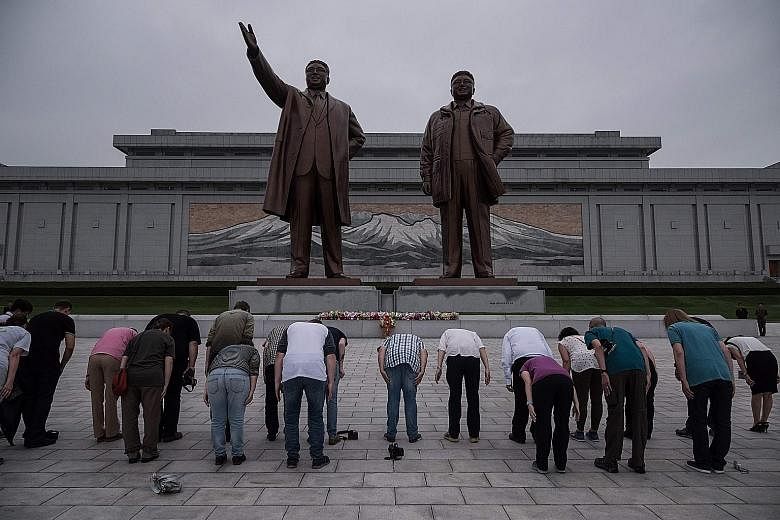PYONGYANG • Visiting Westerners lined up yesterday before giant statues of North Korea's founder Kim Il Sung and his son and successor Kim Jong Il and, on command from their guide, bowed deeply.
It is a ritual the Trump administration plans to stop United States tourists from performing, with Washington due to impose a ban this week on its citizens holidaying in the Democratic People's Republic of Korea, as the North is officially known.
The move comes amid heightened tensions over Pyongyang's missile and nuclear ambitions - it launched a missile earlier this month that specialists say could reach Alaska or Hawaii - and after the death of US student Otto Warmbier, who had been imprisoned for more than a year by Pyongyang.
He was convicted of crimes against the state and sentenced to 15 years' hard labour for trying to steal a propaganda poster from a Pyongyang hotel. He was sent home last month in a mysterious coma that proved fatal soon after.
Most tourists going to North Korea are motivated by curiosity and the desire to experience a different destination.
The iconic 20m statues at Mansu Hill look out over Pyongyang, and groups of North Koreans in suits and ties arrive regularly to pay their respects. Passing traffic is obliged to slow down.
As the tourists reached the platform yesterday, speakers played "We miss our general," referring to the late leader Kim Jong Il. "President Kim Il Sung liberated our country and built a people's paradise on this land," the tourists were told.
Call centre manager Kyle Myers, 28, from Ireland, said he wanted "to go somewhere very different from what I'm used to" for his first trip to Asia, "to see something not a lot of people back home have seen".
Mounting tensions in the year since he booked the tour had made him nervous, he said. Even so, he added: "I don't see the threat here for tourists as long as they behave themselves and they follow the rules of the country."
Some of the visitors - who paid at least €1,850 (S$2,940) for the tour - expressed enthusiasm. Australian IT manager Pallavi Phadke, 43, was among those who placed a bouquet before the statues. "It's the same as covering your head when you go to a mosque or removing your shoes when you go to a temple," she said.
Other tourists were more sceptical. Writer Mark Hill from Calgary in Canada compared the statues to "a very grim Mount Rushmore". "It's all very impressive and also a little disquieting," he said.
For years, the US State Department has warned its citizens against travelling to North Korea, saying they are " at serious risk of arrest and long-term detention under North Korea's system of law enforcement". It notes that North Korea "imposes unduly harsh sentences for actions that would not be considered crimes in the United States", including showing disrespect to the country's leaders and proselytising. It is "entirely possible that money spent by tourists" goes towards funding weapons programmes, adds the department.
The US ban will go into force 30 days after it is formally declared, said department spokesman Heather Nauert, and "US passports will be invalid for travel to, through and in North Korea".
The vast majority of tourists to North Korea are from China, its sole major ally and a key provider of trade and aid. Americans make up around 20 per cent of the 4,000 to 5,000 Western tourists who go to North Korea each year, said Mr Simon Cockerell of Koryo Tours, a leader in the niche market.
Among yesterday's tour group was comedy writer Evan Symon, from Los Angeles, who is likely to be one of the last American tourists to visit the country for several years. "Kind of cool in a way, I guess," he said.
AGENCE FRANCE-PRESSE

